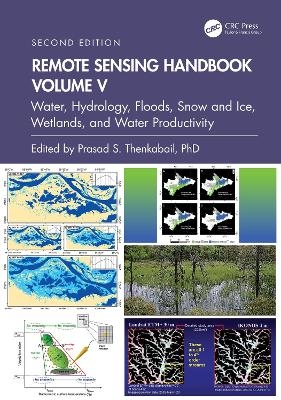
Remote Sensing Handbook, Volume V
CRC Press (Verlag)
978-1-032-89145-3 (ISBN)
- Lieferbar (Termin unbekannt)
- Versandkostenfrei innerhalb Deutschlands
- Auch auf Rechnung
- Verfügbarkeit in der Filiale vor Ort prüfen
- Artikel merken
Volume V of theSix Volume Remote Sensing Handbook, Second Edition, is focused on the use of remote sensing technologies for studying water resources, including groundwater, floods, snow and ice, and wetlands. It discusses water productivity studies from Earth observation data characterization and modeling, mapping their successes and challenges. Chapters include remote sensing of surface water hydrology; quantitative geomorphology; river basin studies; floods; wetlands, including mangroves and river deltas; groundwater studies; crop water use or actual evapotranspiration modeling and mapping; and snow and ice mapping. This thoroughly revised and updated volume draws on the expertise of a diverse array of leading international authorities in remote sensing and provides an essential resource for researchers at all levels interested in using remote sensing. It integrates discussions of remote sensing principles, data, methods, development, applications, and scientific and social context.
FEATURES
Provides the most up-to-date comprehensive coverage of remote sensing science for water resources, including wetlands, floods, snow, and ice.
Provides comprehensive assessments of crop water use and crop water productivity modeling and mapping, including evapotranspiration studies.
Discusses and analyzes data from old and new generations of satellites and sensors spread across 60 years.
Includes numerous case studies on advances and applications at local, regional, and global scales.
Introduces advanced methods in remote sensing, such as machine learning, cloud computing, and artificial intelligence (AI).
Highlights scientific achievements over the last decade and provides guidance for future developments.
This volume is an excellent resource for the entire remote sensing and GIS community. Academics, researchers, undergraduate and graduate students, as well as practitioners, decision makers, and policymakers, will benefit from the expertise of the professionals featured in this book and their extensive knowledge of new and emerging trends.
Dr. Prasad S. Thenkabail, Senior Scientist (ST), United States Geological Survey (USGS), is a world-recognized expert in remote sensing science with major contributions in the field for nearly 40 years. He has made the list of the world’s top 1% of scientists across 22 scientific fields and 176 sub-fields. Dr. Thenkabail has conducted pioneering research in hyperspectral remote sensing of vegetation, global croplands, and their water use for food security. He obtained his PhD from the Ohio State University in 1992 and has 168 peer-reviewed publications including 15 books, including this six-volume set, and over 15 major data releases such as the Landsat-derived global cropland extent product @ 30m and Landsat-derived rainfed and irrigated cropland area product @ 30 m (LGRIP30). He was recognized as a Fellow of the American Society of Photogrammetry and Remote Sensing (ASPRS) in 2023. His scientific papers have won several awards for demonstrating world-class, highest-quality research. He was a Landsat Science Team Member (2007-2011).
Part I: Geomorphology. 1. Geomorphological Studies from Remote Sensing. Part II: Hydrology and Water Resources. 2. Remote Sensing Technologies for Multi-scale Hydrological Studies: Advances and Perspectives. 3. Groundwater Targeting Using Remote Sensing. Part III: Floods. 4. Flood Monitoring using the Integration of Remote Sensing and Complementary Techniques. 5. Flood Studies using Synthetic Aperture Radar Data. 6. Remote Sensing of Mangrove Forests. Part IV: Wetlands. 7. Remote Sensing of Mangrove Wetlands. 8. Wetland Mapping Methods and Techniques Using Multi-Sensor, Multi-Resolution Remote Sensing: Successes and Challenges. 9. Inland Valley Wetland Cultivation and Preservation for Africa’s Green and Blue Revolution using Multi-Sensor Remote Sensing. Part V: Water Use and Water Productivity. 10. Remote Sensing of Evapotranspiration from Croplands. 11. Modeling and Monitoring Water Productivity by Using Geotechnologies: Assessments in some Brazilian Agroecosystems. Part VI: Snow and Ice. 12. Remote Sensing Mapping and Modeling of Snow Cover Parameters and Applications. Part VII: Summary and Synthesis for Volume V. 13. Remote Sensing Handbook, Volume V: Water Resources, Hydrology, Floods, Snow and Ice, Wetlands, and Water Productivity.
| Erscheinungsdatum | 13.11.2024 |
|---|---|
| Reihe/Serie | Remote Sensing Handbook |
| Zusatzinfo | 54 Tables, black and white; 89 Line drawings, color; 23 Line drawings, black and white; 54 Halftones, color; 17 Halftones, black and white; 143 Illustrations, color; 40 Illustrations, black and white |
| Verlagsort | London |
| Sprache | englisch |
| Maße | 178 x 254 mm |
| Gewicht | 1190 g |
| Themenwelt | Informatik ► Grafik / Design ► Digitale Bildverarbeitung |
| Naturwissenschaften ► Geowissenschaften ► Geografie / Kartografie | |
| Naturwissenschaften ► Geowissenschaften ► Hydrologie / Ozeanografie | |
| Technik ► Bauwesen | |
| Technik ► Elektrotechnik / Energietechnik | |
| Technik ► Umwelttechnik / Biotechnologie | |
| ISBN-10 | 1-032-89145-9 / 1032891459 |
| ISBN-13 | 978-1-032-89145-3 / 9781032891453 |
| Zustand | Neuware |
| Informationen gemäß Produktsicherheitsverordnung (GPSR) | |
| Haben Sie eine Frage zum Produkt? |
aus dem Bereich


